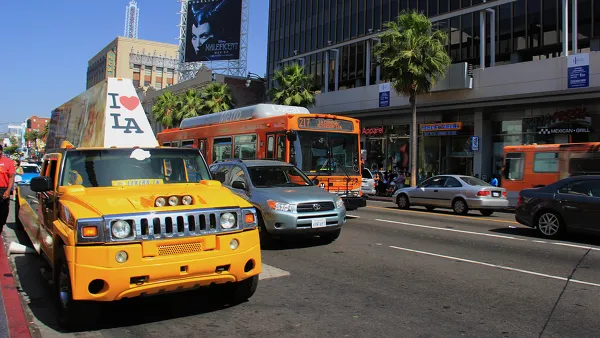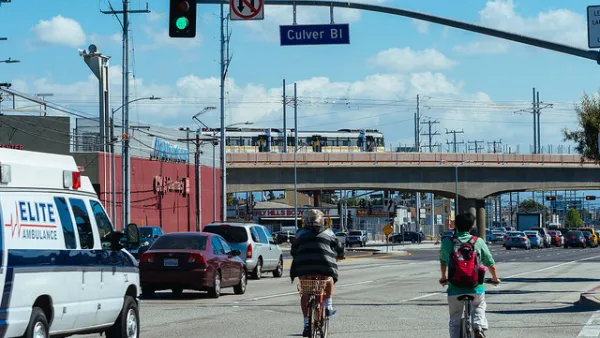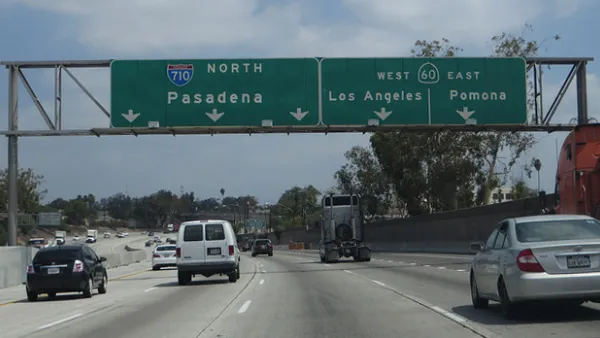It's no longer just transit agencies that are trying to meet the first mile-last mile challenge—auto companies have also jumped in by offering "mobility services." And it's more profitable than selling cars!
Individual car ownership is not going away. "Peak car," the notion that vehicle-miles-traveled peaked in 2007, has been shattered: 2015 set a new record, which is on track to be replaced by 2016. As Washington Post urban columnist, Emily Badger, noted in an urban mobility discussion in August, "76 percent of people get to work every day in a car that they drive alone."
However, demographic changes (and not just those associated with urban millennials) and disruptive technologies are making a difference, particularly in cities. "So carmakers are looking ahead to a day when the automobile plays a smaller role, or even no role at all, in many people’s daily routines," writes Neal Boudette, automotive reporter for The New York Times, in a column for the Wheels feature.
One clear sign of the shift is the increasing energy that carmakers are devoting to a design category the auto industry refers to as the “the first mile/last mile” challenge. It refers to the short distances some people must travel from home or work to a local destination, often a mass transit station.
“People really didn’t think of the first mile/last mile issue because the car was the primary way to get around,’’ said Erica Klampfl, the global future mobility manager at Ford Motor Company. “You just drove your car to your destination.
Boudette's focus is Southern California, particularly the commute changes resulting from Los Angeles Metro's investment in fixed rail, especially among millennials, since the passage of the $40 billion transportation sales tax known as Measure R in 2008, which will continue thanks to voters who overwhelmingly approved the $120 billion transportation sales tax Measure M in November.
Boudette describes the commute patterns of two young women which illustrate the change in mobility needs prompted by the success of two new fixed-rail infrastructure investments.
- Kelly Skow, a 28-year-old video producer, now transfers to the Expo Line from the Los Angeles subway (Red Line). Thanks to the new 6.6-mile, seven-station Expo Line extension from Culver City Station to Downtown Santa Monica Station that opened May 20, she is able to get to her job in Santa Monica. As of September, the extension was 70 percent toward meeting its 2030 ridership projection.
"She usually covers the first and last mile of the trip on foot," adds Boudette.
“I had barely ridden the subway before the Expo Line [extension] opened, but now I’m using it a lot more and it’s great," said Skow. "Parking in L.A. is a nightmare and you don’t have to deal with that.”
- Another Metro investment, the 11.5-mile Gold Line Foothill Extension serving six stations in the San Gabriel Valley of Los Angeles County that opened March 5, has expanded travel options for Monica Manjarres, a 21-year-old college student attending Azusa Pacific University. The university has a station that it shares with Citrus College. Like Skow, Manjarres, an Azusa resident, walks to a light rail station.
Neither woman has given up her car, but they are driving less thanks to expanded public transit. However, the first mile-last mile access to and from light rail stations remains a challenge for those not lucky enough to walk.
Boudette describes the panoply of mobility services that are being offered to meet the need, from transportation network companies that hope to utilize self-driving cars, bike sharing sponsored by auto companies, to Ford's Segway-type device, the Carr-E. But in addition to meeting a need, is it profitable to provide mobility services?
According to the consulting firm PwC, the global automotive industry generates about $400 billion a year in profits; about 41 percent of that — or about $164 billion — comes from new vehicle sales.
By 2030, PwC forecasts that even as overall automotive profits grow to about $600 billion, only about 29 percent of that will come from new vehicle sales. By then, PwC predicts that “mobility services’’ — including ride-hailing and other types of last-mile transportation services — will represent 20 percent of the automotive industry’s profits.
Courtesy of McKinsey & Company: "Urban mobility at a tipping point," September 2015
As for profits, Ford Motor Company "sees mobility services as potentially more profitable than its traditional business of making and selling cars," adds Boudette. "Manufacturing vehicles requires billions of dollars in investments in plants and engineering — costs that are often difficult to recoup."
Mobility services would require less upfront investment, Robert Shanks, Ford’s chief financial officer, said in an interview. “Margins could be more like 20 percent instead of the 8 percent we are trying to get to today,” he said
But not all in the auto world are true believers in embracing mobility services.
The same day Neal Boudette's article was published in the The Times, Neil Winton, European columnist for Autos Insider, penned a column for The Detroit News embracing a more traditional view for the future of the industry.
“Mobility Solutions” is the fashionable drumbeat from the world’s leading automotive manufacturers, likely softened up by smooth-talking consultants spreading fear and confusion, and sensing paranoia.
In the face of this smooth persuasion, it is worth remembering that there are some underlying givens in the automotive world, which aren’t going to change anytime soon. People love cars and the individual freedom and mobility they provide.
And yet all the big car manufacturers have been rushing around bleating sociological “solutions” jargon and investing good money in firms reinventing the taxi, and setting up firms into car sharing and shared mobility.
He has a point. Boudette writes that the "less compact and walkable" city of Azusa in the San Gabriel Valley has opted for a "car-centric solution" to meet its first mile challenge: a 500-space parking garage. Apparently the "connected vehicle" solutions to the parking crunch noted by Planetizen correspondent Josh Williams in May did not mitigate the parking demand.
++++++++++++++++++++++++++++++++
Related in media:
- The Detroit News: Analysis: Auto ‘mobility’ drumbeat suggests paranoia, Dec. 22, 2016
- Tech in Asia: The unstoppable decline of the car industry, Jan 10, 2016
- McKinsey & Company: Report: Disruptive trends that will transform the auto industry, January 2016
- UrbanizeHub: The decline of car ownership in cities, September 7, 2016
- The Wall Street Journal via MarketWatch: Private car ownership is on the road to becoming a rarity, Dec 23, 2015
- McKinsey & Company: Urban mobility at a tipping point, September 2015
Related coverage in Planetizen:
- How Los Angeles Redefined Mobility as a Service, November 2, 2016: Los Angeles Department of Transportation General Manager Seleta Reynolds discusses her vision for urban mobility and the growing role of city leadership.
- Meet the 'Top 10 Private Sector Disrupters in Transportation, July 23, 2016: Names like Zipcar, Uber, and Musk can be found on the list, along with names that aren't quite household…yet.
- From Taxi Industry Disrupter to Auto Industry Disrupter, October 8, 2015: Car ownership is far from "a thing of the past," as Uber's CEO plans on making it, but a new survey shows that a substantial number of people who have tried transportation network companies are forgoing the purchase of a car.
Hat tips to Kenyon Karl and Stuart M. Whitaker
FULL STORY: Automakers Prepare for an America That’s Over the Whole Car Thing

Analysis: Cybertruck Fatality Rate Far Exceeds That of Ford Pinto
The Tesla Cybertruck was recalled seven times last year.

National Parks Layoffs Will Cause Communities to Lose Billions
Thousands of essential park workers were laid off this week, just before the busy spring break season.

Retro-silient?: America’s First “Eco-burb,” The Woodlands Turns 50
A master-planned community north of Houston offers lessons on green infrastructure and resilient design, but falls short of its founder’s lofty affordability and walkability goals.

Test News Post 1
This is a summary

Analysis: Cybertruck Fatality Rate Far Exceeds That of Ford Pinto
The Tesla Cybertruck was recalled seven times last year.

Test News Headline 46
Test for the image on the front page.
Urban Design for Planners 1: Software Tools
This six-course series explores essential urban design concepts using open source software and equips planners with the tools they need to participate fully in the urban design process.
Planning for Universal Design
Learn the tools for implementing Universal Design in planning regulations.
EMC Planning Group, Inc.
Planetizen
Planetizen
Mpact (formerly Rail~Volution)
Great Falls Development Authority, Inc.
HUDs Office of Policy Development and Research
NYU Wagner Graduate School of Public Service





























